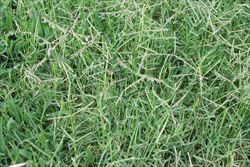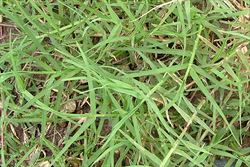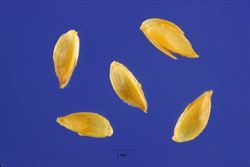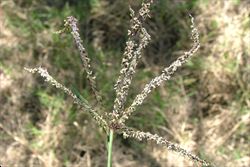Click on images to enlarge

infestation (Photo: Sheldon Navie)

habit (Photo: Sheldon Navie)

stems and leaves (Photo: Sheldon Navie)

creeping stems (Photo: Sheldon Navie)

close-up of stem and smaller leaves (Photo: Sheldon Navie)

seed-head on slender stem (Photo: Sheldon Navie)

close-up of seeds (Photo: Steve Hurst at USDA PLANTS Database)

African star grass (Cynodon nlemfuensis), a very similar grass with more robust flowering stems up to 60 cm tall (Photo: Sheldon Navie)
Scientific Name
Cynodon dactylon (L.) Pers. var. dactylon
Synonyms
Capriola dactylon (L.) KuntzeDactylon officinale Vill.Digitaria dactylon Scop.Milium dactylon MoenchPanicum dactylon L.Paspalum umbellatum Lam.
Family
Gramineae (South Australia)Poaceae (Queensland, New South Wales, the ACT, Victoria, Tasmania, Western Australia and the Northern Territory)
Common Names
African couch, Bahama grass, Bahamas grass, balama grass, baramagrass, Bermuda grass, Bermuda-grass, Bermudagrass, common Bermuda grass, coarse kweek, common couch, common quickgrass, common stargrass, couch, couch grass, couch-grass, couchgrass, devilgrass, devil's grass, dhubgrass, dog's tooth, doob, doob grass, dub grass, finegrass, finger grass, fingers, Florida grass, giant Bermuda grass, giant Bermudagrass, green couch, Indian couch, Indian doab, kweek grass, quickgrass, running grass, Scotch grass, star grass, twitch grass
Origin
This species is very widely distributed throughout the world (including in large parts of Australia), and its exact origin is unknown. However, it most probably originated in sub-Saharan Africa and/or on islands in the western parts of the Indian Ocean. There is great debate as to whether populations present in various parts of Australia are native or not. Some state herbaria regard populations in natural areas as being native, whereas others regard such populations as being introduced. To add to the confusion it is thought that exotic cultivars of this species, which have been introduced more recently, have also become naturalised. Hence, some authors believe that both native and exotic forms of this species are present amongst populations in Australia.
The majority of current opinion is that at least some forms of green couch (Cynodon dactylon var. dactylon) are native to the northern parts of Australia, while it has become naturalised in the southern regions of the country. However, the most recent research suggests that even the "native" forms present in northern Australia probably came from a very early (i.e. possibly pre-European) introduction.
Note: Another variety of this species, known as Cynondon dactylon var. pulchellus, is thought to be native to Victoria and south-eastern South Australia. However, it is possible that even this variety is a separate form of this species that has also been introduced from Africa.
Naturalised Distribution
Green couch (Cynodon dactylon var. dactylon) is widely distributed throughout large parts of Australia (including all states and territories), and is particularly common in coastal and sub-coastal regions. It is regarded as being native in Queensland and New South Wales and introduced in Victoria, South Australia, Tasmania and the Northern Territory. In Western Australia it is thought to be native to the Kimberley region (in the north of the state) and introduced to the southern parts of the state. Also present on Lord Howe Island, Norfolk Island, Christmas Island, the Cocos Islands and the Coral Sea Islands (where it is regarded as being native or a very early introduction).
Notes
This very common lawn and pasture grass is sometimes considered native and at other times it is considered to be an important environmental weed (even by different authorities and experts within the same state). Green couch (Cynodon dactylon var. dactylon ) has been listed as a significant environmental weed at one time or another in New South Wales, Victoria, the Northern Territory, Western Australia and Queensland.
In certain situations, green couch (Cynodon dactylon var. dactylon) spreads quickly via creeping stems (i.e. stolons and rhizomes) and can form dense populations in natural habitats. For example, it is reported to invade wetlands and river edges in the southern parts of Western Australia. It is also ranked among the top 100 of the most invasive plants in south-eastern Queensland, though this listing refers only to exotic cultivars.

